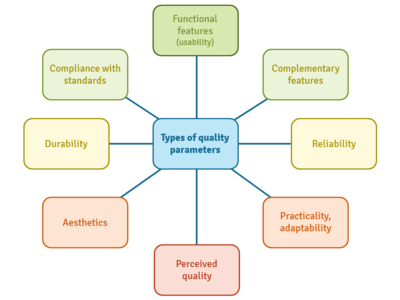Quality parameters: Difference between revisions
(Infobox update) |
mNo edit summary |
||
| Line 27: | Line 27: | ||
* aesthetics, product reception, | * aesthetics, product reception, | ||
* [[perceived quality]], closely related to the product's [[brand]] and [[supplier]]'s reputation. | * [[perceived quality]], closely related to the product's [[brand]] and [[supplier]]'s reputation. | ||
These criteria are dynamic and depend on the following elements: | These criteria are dynamic and depend on the following elements: | ||
| Line 33: | Line 34: | ||
* society, | * society, | ||
* nature. | * nature. | ||
[[File:types_of_quality_parameters.png|400px|right|thumb|Fig.1. Types of quality parameters]] | |||
The quality parameters are determined by the actual condition of the [[company]] and its surroundings as well as the properties of raw materials and the technological [[process]] used during [[production]]. Improperly used technologies, inadequate [[environment]] of production processes, poor storage and [[transport]] may negatively affect [[product quality]]. These parameters can also be divided according to the group of features that contain a specific number and type of detailed [[qualitative characteristics]] depending on the [[needs]] to be met. These are: | The quality parameters are determined by the actual condition of the [[company]] and its surroundings as well as the properties of raw materials and the technological [[process]] used during [[production]]. Improperly used technologies, inadequate [[environment]] of production processes, poor storage and [[transport]] may negatively affect [[product quality]]. These parameters can also be divided according to the group of features that contain a specific number and type of detailed [[qualitative characteristics]] depending on the [[needs]] to be met. These are: | ||
Revision as of 11:57, 8 September 2020
| Quality parameters |
|---|
| See also |
Quality parameter - the size characterizing the quality level of certain consumer and production goods and processes leading to the production of a given good.
The quality is described by eight dimensions characterizing, in various respects, the data of good and determining their essence and purpose, i.e.:
- functional features of the product, usability in accordance with the characteristics of the essence of the object,
- features that complement the basic functional features of the product,
- reliability, ability to work trouble-free,
- practicality, adaptability of the product, ease of use and maintenance,
- compliance with the standard requirements,
- durability, the possibility of using the product for a limited time,
- aesthetics, product reception,
- perceived quality, closely related to the product's brand and supplier's reputation.
These criteria are dynamic and depend on the following elements:
- industry,
- users,
- society,
- nature.
The quality parameters are determined by the actual condition of the company and its surroundings as well as the properties of raw materials and the technological process used during production. Improperly used technologies, inadequate environment of production processes, poor storage and transport may negatively affect product quality. These parameters can also be divided according to the group of features that contain a specific number and type of detailed qualitative characteristics depending on the needs to be met. These are:
- Natural and technical features, all product features given to them by nature or obtained as a result of technological processes, according to standards containing basic parameters of structure and function of these products. This group consists of physical, chemical and biological distinctions). They have an objective character, because they can be compared with existing patterns.
- Economic features are elements of the quality structure of goods that give users a measurable sum of benefits. Expressed using economic indicators, e.g. depreciation.
- The functional features make the products able to satisfy material (technical) as well as intangible (brand image, i.e. branded product) consumer needs. These are, for example, durability, ease of use and maintenance, comfort in use.
- Ergonomic properties, adjustment of products to anatomical, physiological and psychological features of a human being.
- Aesthetic features that characterize the appearance. They are shape, colors, external construction solutions.
- Ecological features, determined by the properties of goods, making them environmentally friendly.
References
- Gabszewicz, J. J., & Thisse, J. F. (1979). Price competition, quality and income disparities. Journal of economic theory, 20(3), 340-359.
- Schulz, H., Joubert, E., & Schütze, W. (2003). Quantification of quality parameters for reliable evaluation of green rooibos (Aspalathus linearis). European Food Research and Technology, 216(6), 539-543.
